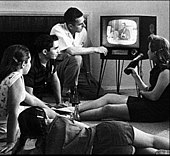This article needs additional citations for verification. (December 2023) |
| This article is part of a US culture series on the |
| Television of the United States |
|---|
 |
From the 1950s to the 1980s, during the network era of American television, there were three commercial broadcast television networks – NBC (the National Broadcasting Company, "the Peacock Network"), CBS (the Columbia Broadcasting System, "the Eye Network"), ABC (the American Broadcasting Company, "the Alphabet Network") – that due to their longevity and ratings success are informally referred to as the "Big Three". The three networks' dominance was interrupted with the launch of Fox (the Fox Broadcasting Company, "the Searchlight Network") in 1986, leading it to join them as one of the expanded "Big Four", while the viewership shares of all the major broadcast networks declined over the following years.[1]
- ^ Douglas Blanks Hindman; Kenneth Wiegand (2008). "The big three's prime-time decline: a technological and social context" (PDF). Journal of Broadcasting & Electronic Media. Retrieved March 19, 2014.
